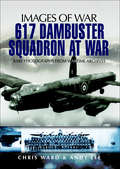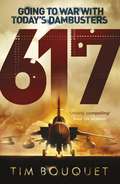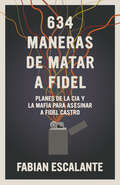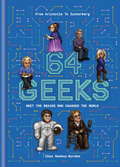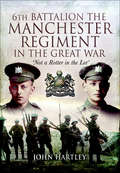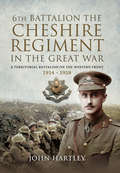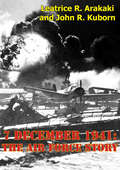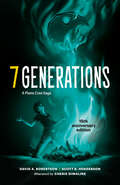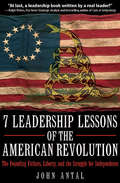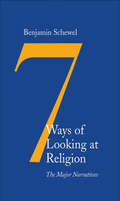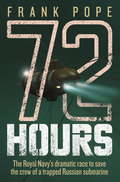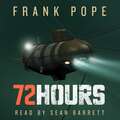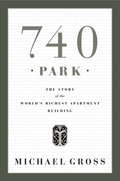- Table View
- List View
60 años de soledad: La vida de Carlota después del Imperio Mexicano
by Gustavo VázquezCarlota pasó de un cuento de hadas a un infierno. Ésta es la historia de ese infierno. La emperatriz volvió a ser princesa. Después de que su marido fuera fusilado en el Cerro de las Campanas, la consentida, la enamorada, se convirtió en una paria de las monarquías europeas y pasó sesenta años en la locura. Esta obra es la primera que se concentra en las seis décadas que Carlota de Sajonia-Coburgo-Gotha vivió después de que se derrumbara el Segundo Imperio Mexicano, y ofrece un estudio lúcido de uno de los personajes más apasionantes en la historia del país. Aquí hablan los diarios de los médicos de Carlota, los papeles de Adrien Goffinet (administrador de sus bienes), testigos de aquellos años, archivos reales, las cartas de su servidumbre, bitácoras de viajeros y la prensa europea de la época. Paso a paso, se revela cómo la "princesa más triste del mundo" terminó convertida en un peón. Y cómo, de las ruinas del México de Maximiliano, surgió el imperio privado del rey belga Leopoldo II en el Congo.
617 Dambuster Squadron At War: Images Of War
by Chris WardNo. 617 Squadron RAF Bomber Command is world-famous for its daring raids on the Mohne, Eder and Sorpe Dams, the Dortmund-Ems Canal and the attacks on the German ship Tirpitz. This book contains rarely seen photographs of the squadrons aircraft, crews and other behind-the-scenes operations. Each image is accompanied by a lengthy caption that convey the location and history surrounding the subject in question.
617: Going to War with Today's Dambusters
by Tim BouquetThe inside story of today's Dambusters, 617 Squadron RAF, at war in Afghanistan.In May 1943, 617 Squadron RAF executed one of the most daring operations in military history as bombers mounted a raid against hydro-electric dams in Germany. 617 Squadron became a Second World War legend. Nearly 70 years later, in April 2011, a new generation of elite flyers, now flying supersonic Tornado GR4 bombers, was deployed to Afghanistan - their mission: to provide close air support to troops on the ground.Tim Bouquet was given unprecedented access to 617's pre-deployment training and blistering tour in Afghanistan. From dramatic air strikes to the life-and-death search for IEDs and low-flying shows of force designed to drive insurgents from civilian cover, he tracked every mission - and the skill, resilience, banter and exceptional airmanship that saw 617 through.
62: Aaron Judge, the New York Yankees, and the Pursuit of Greatness
by Bryan Hoch&“The definitive story&” (Tyler Kepner, The New York Times baseball columnist) of Yankees slugger Aaron Judge&’s incredible, unparalleled run to break Roger Maris&’s home run record and the franchise both men called home.Aaron Judge, the hulking superman who carried an easy aw-shucks demeanor from small-town California to stardom in the Big Apple, had long established his place as one of baseball&’s most intimidating power hitters. Baseballs frequently rocketed off his bat like cannon fire, dispatching heat-seeking missiles toward the &“Judge&’s Chambers&” seating area in right field, sending delirious fans scattering for souvenirs. But even in a high-tech universe where computers measure each swing to the nth degree, Roger Maris&’s American League mark of sixty-one home runs seemed largely out of reach. It had been more than a decade since baseball wiped clean the stains of its performance-enhanced era, in which cartoonish sluggers Mark McGwire, Sammy Sosa, and Barry Bonds made a mockery of the record book. Given a more level playing field against pitchers sporting hellacious arsenals unlike anything Babe Ruth or Maris could have imagined, only an exceptional talent could even consider making a run at sixty-one homers. Judge, who placed the bet of his life by turning down a $213.5 million extension on the eve of the regular season, promised to rise to the challenge. &“In the most thorough telling yet of an all-time-great Yankees performance&” (Jeff Passan, New York Times bestselling author), veteran Yankees beat reporter Bryan Hoch unravels the remarkable journey of Judge&’s run to shatter Maris&’s beloved sixty-one-year-old record. In-depth, inspiring, and with an expert&’s insight, 62 also investigates the more significant questions raised in a season unlike any other, including how—and where—Judge will deliver his encore.
634 Maneras de matar a Fidel: Planes de la CIA y la Mafia para asasinar a Fidel Castro
by Fabian EscalanteExpansivo recuento de los diversos, creativos, frecuentemente extraños y sin embargo increíblemente inquietantes intentos de asesinar a Fidel Castro.Fabián Escalante, el fundador de los servicios de seguridad cubanos y jefe del Departamento de Seguridad del Estado Cubano provee un lúcido recuento en primera persona de sus experiencias defendiendo a Castro contra extraordinarios intentos de homicidio. Escrito en el estilo de una novela de suspenso político, pero lleno de detalles históricos sobre Fidel, Cuba, el movimiento comunista y los intentos de Estados Unidos de silenciar la rebelión, este libro clarifica los peligros inherentes que conlleva luchar por un mundo mejor.634 maneras de matar a Fidel ilumina la amenaza que Castro y el movimiento revolucionario cubano presentaban para la hegemonía estadounidense. El resultado es un inquietante retrato de cómo los impuestos de ciudadanos estadounidenses financian campañas para reprimir el disentimiento e intentar quebrar movimientos en el Sur Global que luchan por la soberanía, la justicia, la autodeterminación y, básicamente, un mundo mejor."Planes de asesinato concebidos contra Fidel Castro a lo largo de muchos años involucraron armas tales como venenos letales, potentes explosivos plásticos, cigarros conteniendo sustancias peligrosas, granadas a lanzar en espacios públicos, armas con telescopios sofisticados, jeringas llenas de veneno con agujas tan finas que el contacto con la piel pasaría desapercibido, lanzadores de misiles y bazucas, y cargas explosivas escondidas en caños bajo tierra con un temporizador contando los minutos y segundos hasta la explosión."
634 Ways to Kill Fidel
by Fabian EscalanteA sprawling account of the various, creative, often bizarre, yet incredibly disturbing attempts to assassinate Fidel Castro. Soon to be a TV series from Jed Mercurio, show runner for "The Bodyguard," and Richard Brown, producer of "True Detective" and "Catch-22."Fabián Escalante, the founder of the Cuban intelligence services, and head of the Cuban State Security Department, provides a clear-eyed first-person account of his experiences defending Fidel Castro from the extraordinary attempts to take his life. From lethal poisons to plastic explosives to bazookas, Escalante introduces and describes an array of assassination plots and historical figures and depicts the ensuing cat-and-mouse game in the midst of the Cold War. Written in the style of a political thriller yet based on real events, 634 Ways to Kill Fidel Castro is a well-researched and documented series of vignettes put together by multiple investigations in Cuba and the experiences of the author, who participated in several of them; dozens of interviews with participants; extensive documentary evidence; and the collaboration of officials, and undercover agents who dismantled these plots. Filled with harrowing stories of deceitful FBI tactics such as moles who infiltrated the revolutionary Cuban government and gained a reputation with them with the ultimate goal of bombing their military bases. As well as undercover attempts to give Fidel poison laced cigars, Escalante takes the reader from DC to New York, Miami to Havana and uncovers the intricate conspiracy to silence dissent and kill Fidel Castro. 634 Ways to Kill Fidel Castro is filled to the brim with historical details on the CIA, Cuba, the communist movement, US government officials, and Fidel himself. Escalante&’s first-hand account provides evidence of the lengths to which the CIA went through to assassinate Fidel Castro and the determined efforts to protect him and what he stood for.
64 Geeks: The Brains Who Shaped Our World
by Chas Newkey-BurdenWe wouldn't have Bluetooth or Wi-Fi today without the ingenuity of an actress once described as "the most beautiful woman in the world."And we might have had mobile messaging as early as 1901, were it not for the fickleness of a banker. From celebrated prodigies and self-proclaimed geniuses to history's hidden heroes-64 GEEKS brings you the incredible stories of the world's best brains, all presented alongside clever 8-bit likenesses.
64 Geeks: The Brains Who Shaped Our World
by Chas Newkey-BurdenWe wouldn't have Bluetooth or Wi-Fi today without the ingenuity of an actress once described as "the most beautiful woman in the world."And we might have had mobile messaging as early as 1901, were it not for the fickleness of a banker. From celebrated prodigies and self-proclaimed geniuses to history's hidden heroes-64 GEEKS brings you the incredible stories of the world's best brains, all presented alongside clever 8-bit likenesses.
6th Battalion, The Manchester Regiment in the Great War
by John HartleyThe 6th Battalion, The Manchester Regiment, was a prewar Territorial unit. Many of its members held white collar positions employed by the Citys legal, financial and stockbroking practices or worked for the major commercial organizations trading and manufacturing cotton goods. It went overseas in September 1914, taking with it many new recruits who would undertake their basic training whilst the Battalion formed part of the British garrison in Egypt.It saw action at Gallipoli from May 1915 until the evacuation at the end of the year and fascinating campaign is dealt with in considerable detail. The Battalion returned to Egypt until the spring of 1917 when it moved to France.The Manchesters saw regular action for most of 1918, coming under attack in the German offensive in March. Throughout the summer and autumn, the Battalion took part in the Advance to Victory and was still advancing when the Armistice was signed in November.The book also recounts the history of the second line battalion, the 2/6th Manchesters, from its inception in 1914 until it was all but destroyed in March 1918.The author draws on official records and personal accounts to tell the story of these fine battalions.
6th Battalion, the Cheshire Regiment in the Great War: A Territorial Battalion on the Western Front 1914–1918
by John HartleyThe 6th Battalion, the Cheshire Regiment, was a prewar Territorial battalion that recruited in the North Cheshire towns of Stockport, Hyde and Stalybridge, together with the Derbyshire town of Glossop. The majority of its part-time soldiers worked in the areas cotton mills and hat making factories. One of the first Territorial battalions to see action in the Great War, it went overseas in November 1914, taking part in the famous Christmas truce a few weeks later.In 1916, it saw major action during the Battle of the Somme. The following year, it suffered heavy casualties during the action around the Belgian town of Ypres, which is often known as the Battle of Passchendaele. In 1918 the Battalion fought to hold off German advances in the spring but, along with the rest of the BEF, was forced to retreat many miles. By the summer of that year the tide had turned and the Cheshire's took part in the final advances that ended the war in November.The story is told from the Battalions formation in 1908 to its disbandment in the 1920s and beyond with details of the Old Comrades Association. Official accounts are supplemented by the mens own words, taken from diaries, letters and newspaper reports.
6th SS Mountain Division Nord at War, 1941–1945: Rare Photographs from Wartime Archives (Images of War)
by Ian BaxterDrawing on a superb collection of rare and unpublished photographs the 6th SS Mountain Division Nord 1941 - 1945 is the 6th book in the Waffen-SS Images of War Series compiled by Ian Baxter. The book tells the story of the 6th SS Mountain Division Nord, which was formed in February 1941 as SS Kampfgruppe Nord (SS Battle Group North). The Division was the only Waffen-SS unit to fight in the Arctic Circle when it was stationed in Finland and northern Russia between June and November 1941. It fought in Karelia until the Moscow Armistice in September 1944, at which point it left Finland. It suffered heavy losses in the Operation Nordwind in January 1945 and in early April 1945, the division was destroyed by the US forces near Budingen, Germany.
7 December 1941: The Air Force Story [Illustrated Edition]
by Leatrice R. Arakaki John R. KubornIncludes 3 charts, 7 tables and 137 photosDecember 7, 1941, was by any assessment a devastating day. The Hawaiian Air Force suffered a crippling blow, but the genesis of recovery and final victory over the enemy emerged in the valor of those who weathered the onslaught and fought back with everything they had.In the 50 years since then, the attack has become a faded memory for some and to many members of the younger generation just another moment in history. It deserves better understanding and commemoration, however, for this sudden, damaging strike on our forces marked the beginning of America's involvement in a terrible global war that was massive in scope and destruction.At Hickam Air Force Base, reminders of the attack are still visible. The tattered flag that flew over the base that fateful morning is encased and on display in the lobby of the Pacific Air Forces Headquarters building, where bullet-scarred walls serve as a constant reminder to never again be caught unprepared. Memorial tablets surrounding the base flagpole pay tribute to those who sacrificed their lives for our country.Our predecessors, with their blood and sweat, boldly wrote a major chapter of our military history. We must never forget their story and the legacy of their experience--that the price of freedom is eternal vigilance and readiness.
7 Generations: A Plains Cree Saga (7 Generations)
by David A. Robertson"[David A. Robertson] weaves an engrossing and unforgettable story with the precision of a historian and the colour of a true Indigenous storyteller."—Rosanna Deerchild From the bestselling author of The Misewa Saga and When We Were Alone, comes 7 Generations: A Plains Cree Saga. This epic series of young adult graphic novels follows one Cree family over three centuries and seven generations. Edwin, a Cree teenage boy, is struggling to feel connected to his family and his identity. From stories shared by his mother, Edwin learns about the history of his family, through the years of war, a smallpox epidemic, and residential schools, all the way through to the present and the conflicts Edwin faces in his own life. Edwin must confront the past to heal in the present—but can his father, scarred by his own residential school experience, heal in time to help Edwin? This special 15th anniversary edition brings together all four titles in the 7 Generations series, recoloured and relettered, with a preface from author David A. Robertson and an afterword from bestselling author Cherie Dimaline.
7 Greeks
by Guy Davenport"Overall, this volume will afford great pleasure to scholars, teachers, and also those who simply love to watch delightful souls disport themselves in language."--Anne Carson Here is a colorful variety pf works by seven Greek poets and philosophers who lived from the eighth to the third centuries BC. Salvaged from shattered pottery vases and tattered scrolls of papyrus, everything decipherable from the remains of these ancient authors is assembled here. From early to later, the collection contains: Archilochos; Sappho; Alkman; Anakreon; the philosophers Herakleitos and Diogenes; and Herondas. This composite of fragments translated by Guy Davenport is the most complete collection of its kind ever to appear in one volume.
7 Leadership Lessons of D-Day: Lessons from the Longest Day—June 6, 1944
by John Antal<p>“Drawing universal truths from urgent battlefield crises, the author provides a terrific guide and training tool for leaders at all levels” (Ralph Peters, New York Times–bestselling author).<p> <p>The odds were against the Allies on June 6, 1944. The task ahead of the paratroopers who jumped over Normandy and the soldiers who waded ashore onto the beaches, all under fire, was colossal. In such circumstances, good leadership can be the deciding factor of victory or defeat. This book is about the extraordinary leadership of seven men who led American soldiers on D-Day and the days that followed. Some of them, like Eisenhower, Theodore Roosevelt Jr., and Lt. Dick Winters, are well known, while others are barely a footnote in the history books.<p> <p>This book is not a full history of D-Day, nor does it cover the heroic leadership shown by men in the armies of the Allies or members of the French Resistance, who also participated in the Normandy assault and battles for the lodgment areas. It is, however, a primer on how you can lead today, no matter what your occupation or role in life, by learning from the leadership of these seven figures.<p> <p>A critical task for every leader is to understand what leadership is. Socrates once said that you cannot understand something unless you can first define it in your own words. This book provides the reader with the means to define leadership by telling seven dramatic, immersive, and memorable stories that the reader will never forget.<p>
7 Leadership Lessons of the American Revolution: The Founding Fathers, Liberty, and the Struggle for Independence
by John Antal“A leadership book written by a real leader! . . . eminently useful for those ‘in command’ of organizations of any kind. A stimulating five-star work” (Ralph Peters, New York Times–bestselling author).This book tells the dramatic story of seven defining leadership moments from the American Revolution, as well as providing case studies that can improve your leadership at home, business, in your community, in the military, or in government.Leadership is not about position, it is about influence. You can be a leader no matter what your rank or position. It is not about power, it is about selflessness. You cannot be a good leader unless you can also be a good follower. Good leaders don’t shine, they reflect. Lessons like these are the core of this book. The stories in this book are about leaders who were challenged at all corners, adapted, improvised and overcame. The tales of leaders like Samuel Adams, Patrick Henry, Henry Knox, Benjamin Franklin, and George Washington, to name a few, are stories you will want to know and tell. These leaders knew how to push teams to succeed under the toughest conditions. These stories will come alive on the pages of this book to fuel your leadership fire and make you a better leader in any endeavor. Learn how they secured our liberty so you can transform today into a better tomorrow.“John Antal has captured seven timeless stories that will raise your leadership awareness and make you a better leader in peace or war, at home, at work or in your community.” —Steven Pressfield, bestselling author of 36 Righteous Men
7 Ways of Looking at Religion: The Major Narratives
by Benjamin SchewelAn ambitious scholar&’s lucid analysis of religion&’s shifting place in the modern world.Western intellectuals have long theorized that religion would undergo a process of marginalization and decline as the forces of modernity advanced. Yet recent events have disrupted this seductively straightforward story. As a result, while religion has somehow evolved from its tribal beginnings up through modernity and into the current global age, there is no consensus about what kind of narrative of religious change we should alternatively tell.Seeking clarity, Benjamin Schewel organizes and evaluates the prevalent narratives of religious history that scholars have deployed over the past century and are advancing today. He argues that contemporary scholarly discourse on religion can be categorized according to seven central narratives: subtraction, renewal, transsecular, postnaturalist, construct, perennial, and developmental. Examining the basic logic, insights, and limitations of each of these narratives, Schewel ranges from Martin Heidegger to Muhammad Iqbal, from Daniel Dennett to Charles Taylor, to offer an incisive, broad, and original perspective on religion in the modern world.&“The book should be a widely read guide to the ideas that structure many of the debates scholars are having today about the meaning of postsecularism and future of religion.&” —Geoffrey Cameron, Review of Faith and International Affairs"What is the future of religion and how should we narrate its past? For all readers interested in these questions, this balanced and concise book is a must read.&” —Hans Joas, Humboldt University, Berlin, and University of Chicago
7,000 Clams: A Novel
by Lee IrbyFrank Hearn is a down-on-his-luck bootlegger and bruiser, looking for the big score in the heart of the Roaring Twenties. When he loses a shipment of top-quality booze to a double-crossing government thief, Frank hunts him down, roughs him up, and finds something that catches his eye. What at first appears to be a scrap of paper is actually a handwritten and unmistakably authentic IOU for $7,000, signed by Babe Ruth. Seven-thousand clams is a lot of money--and when Frank gets a tip that the Yankees are about to begin spring training in St. Petersburg, Florida, he wastes no time leaving New Jersey to track down the Babe. Frank thinks he's covered his bases: Along for the ride is a dangerous and curvy blonde named Ginger DeMore. She's smart, she packs a snub-nose pistol in her purse, and she's the perfect accomplice to help convince the Babe to cough up the dough. It seems like the perfect plan, but Frank and Ginger aren't the only ones seeking their fortunes in Florida. 1920's St. Pete is a veritable nest of vipers. Hustlers, gamblers, Yankee fans, and even a sociopath are lurking in the booming burg--not to mention a team of gangsters sent by a prominent Chicago mobster named Al Capone (who's instructed his boys to scour the town for a curvy dame by the name of Ginger DeMore). In this taut Roaring Twenties crime novel, filled with colorful characters both real and imagined, Lee Irby takes readers straight into the authentic heart of the era, bringing to life all the sizzling style--from the slang and the fashions to the smell of bathtub gin. Worthy of a place at Elmore Leonard's table, 7,000 CLAMS is an enormously entertaining tale and a superb fiction debut.
70 Years of China’s Bridges
by Wei Xu Zhongfu Xiang Anshuang Liu Fanchao MengThe book takes time as the axis, selecting 98 bridges (or bridge groups) across the country and 7 representative bridges out of the country, reflecting the steps and development of China's bridge construction in related majors and engineering technicians in colleges and universities. This book aims to let the general public understand the arduous history of China's bridge construction and the rapid development of China's bridge construction without the country's economic development, strength, and hard work of the bridge people. It is also hoped that the public will enjoy the convenience of bridges, highways, railroads, and urban roads and at the same time enhance their awareness of bridge knowledge, knowledge, love, and scientific use of bridges. This book is used by the general public to understand the development of China's bridge construction, but also as a reference book for teachers and students of bridge engineering-related majors and engineering technicians in colleges and universities.
70 Years of Opening-up in China’s Education
by Xiaobing SunThis book gives a panoramic review and summary on the opening up of China’s education to the outside world. Firstly, it introduces the connotation of international education, the development history of international education in China, national legislation and vital released documents. It also provides a general view of historical actuality and classic cases interpretation on the principal components of China’s international education, namely overseas studying, international students studying in China, Sino-foreign cooperative education, overseas school running, cultural exchanges with other countries, multilateral exchanges, “the Belt and Road” educational actions and macro-management departments of international education. This book is bilingual in both Chinese and English and is an essential guidebook for readers to understand how international education has developed in China
72 Hours
by Frank PopeThe Royal Navy's dramatic race to save the crew of a trapped Russian submarine.5 August 2005. On a secret mission to an underwater military installation 30 miles off the coast of Kamchatka, Russian Navy submersible AS-28 ran into a web of cables and stuck fast. With 600 feet of freezing water above them, there was no escape for the seven crew. Trapped in a titanium tomb, all they could do was wait as their air supply slowly dwindled.For more than 24 hours the Russian Navy tried to reach them. Finally - still haunted by the loss of the nuclear submarine Kursk five years before - they requested international assistance. On the other side of the world Commander Ian Riches, leader of the Royal Navy's Submarine Rescue Service, got the call: there was a sub down.With the expertise and specialist equipment available to him Riches knew his team had a chance to save the men, but Kamchatka was at the very limit of their range and time was running out. As the Royal Navy prepared to deploy to Russia's Pacific coast aboard a giant Royal Air Force C-17 airlifter, rescue teams from the United States and Japan also scrambled to reach the area.On board AS-28 the Russian crew shut down all non-essential systems, climbed into thick thermal suits to keep the bone-chilling damp at bay and waited, desperate to eke out the stale, thin air inside the pressure hull of their craft. But as the first of them began to drift in and out of consciousness, they knew the end was close. They started writing their farewells.72 HOURS tells the extraordinary, edge-of-the-seat and real-life story of one of the most dramatic rescue missions of recent years.
72 Hours
by Frank Pope5 August 2005. On a secret mission to an underwater military installation 30 miles off the coast of Kamchatka, Russian Navy submersible AS-28 ran into a web of cables and stuck fast. With 600 feet of freezing water above them, there was no escape for the seven crew. Trapped in a titanium tomb, all they could do was wait as their air supply slowly dwindled.For more than 24 hours the Russian Navy tried to reach them. Finally - still haunted by the loss of the nuclear submarine Kursk five years before - they requested international assistance. On the other side of the world Commander Ian Riches, leader of the Royal Navy's Submarine Rescue Service, got the call: there was a sub down.With the expertise and specialist equipment available to him Riches knew his team had a chance to save the men, but Kamchatka was at the very limit of their range and time was running out.As the Royal Navy prepared to deploy to Russia's Pacific coast aboard a giant Royal Air Force C-17 airlifter, rescue teams from the United States and Japan also scrambled to reach the area.On board AS-28 the Russian crew shut down all non-essential systems, climbed into thick thermal suits to keep the bone-chilling damp at bay and waited, desperate to eke out the stale, thin air inside the pressure hull of their craft. But as the first of them began to drift in and out of consciousness, they knew the end was close. They started writing their farewells.72 HOURS tells the extraordinary, edge-of-the-seat and real-life story of one of the most dramatic rescue missions of recent years.Read by Sean Barrett(p) 2012 Isis Publishing Ltd
73 North: The Battle of the Barents Sea
by Dudley PopeThe events and decisions that culminated in the Battle of the Barents Sea—what many consider to be the most important naval engagement of World War II's European theatre—in which eight of the German navy's most powerful ships failed to sink a Russian convoy guarded by only four small British destroyers, are brought to life by the author in this tale of men struggling to carry out their orders in the face of overwhelming obstacles.
740 Park: The Story of the World's Richest Apartment Building
by Michael GrossFor seventy-five years, it's been Manhattan's richest apartment building, and one of the most lusted-after addresses in the world. One apartment had 37 rooms, 14 bathrooms, 43 closets, 11 working fireplaces, a private elevator, and his-and-hers saunas; another at one time had a live-in service staff of 16. To this day, it is steeped in the purest luxury, the kind most of us could only imagine, until now. The last great building to go up along New York's Gold Coast, construction on 740 Park finished in 1930. Since then, 740 has been home to an ever-evolving cadre of our wealthiest and most powerful families, some of America's (and the world's) oldest money--the kind attached to names like Vanderbilt, Rockefeller, Bouvier, Chrysler, Niarchos, Houghton, and Harkness--and some whose names evoke the excesses of today's monied elite: Kravis, Koch, Bronfman, Perelman, Steinberg, and Schwarzman. All along, the building has housed titans of industry, political power brokers, international royalty, fabulous scam-artists, and even the lowest scoundrels.The book begins with the tumultuous story of the building's construction. Conceived in the bubbling financial, artistic, and social cauldron of 1920's Manhattan, 740 Park rose to its dizzying heights as the stock market plunged in 1929--the building was in dire financial straits before the first apartments were sold. The builders include the architectural genius Rosario Candela, the scheming businessman James T. Lee (Jacqueline Kennedy Onassis's grandfather), and a raft of financiers, many of whom were little more than white-collar crooks and grand-scale hustlers. Once finished, 740 became a magnet for the richest, oldest families in the country: the Brewsters, descendents of the leader of the Plymouth Colony; the socially-registered Bordens, Hoppins, Scovilles, Thornes, and Schermerhorns; and top executives of the Chase Bank, American Express, and U.S. Rubber. Outside the walls of 740 Park, these were the people shaping America culturally and economically. Within those walls, they were indulging in all of the Seven Deadly Sins. As the social climate evolved throughout the last century, so did 740 Park: after World War II, the building's rulers eased their more restrictive policies and began allowing Jews (though not to this day African Americans) to reside within their hallowed walls. Nowadays, it is full to bursting with new money, people whose fortunes, though freshly-made, are large enough to buy their way in. At its core this book is a social history of the American rich, and how the locus of power and influence has shifted haltingly from old bloodlines to new money. But it's also much more than that: filled with meaty, startling, often tragic stories of the people who lived behind 740's walls, the book gives us an unprecedented access to worlds of wealth, privilege, and extraordinary folly that are usually hidden behind a scrim of money and influence. This is, truly, how the other half--or at least the other one hundredth of one percent--lives.
747
by Jay Spenser Joe Sutter747 is the thrilling story behind "the Queen of the Skies"-the Boeing 747-as told by Joe Sutter, one of the most celebrated engineers of the twentieth century, who spearheaded its design and construction. Sutter's vivid narrative takes us back to a time when American technology was cutting-edge and jet travel was still glamorous and new. With wit and warmth, he gives an insider's sense of the larger than life-size personalities-and the tensions-in the aeronautical world.

